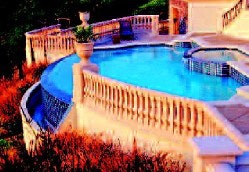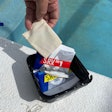
Remember the first time you saw a vanishing-edge pool? Once you got past the sheer beauty of the effect, you probably wondered, "How'd they do that?"
In the 21st century, vanishing edges — also called negative edges or infinity edges — are common enough that lots of the engineering puzzles have been worked out. But it's still a detail that you probably shouldn't attempt on the first pool you build.
Mike Sorenson, manager of the San Gabriel, Calif., office of California Pools has 30-plus years of experience in pool building, and he graciously shared the wisdom he's accumulated on the basics of vanishing edge details.
LESSONS LEARNED
Sorenson says understanding the concept of surge capacity and the process of capturing overflow is the key.
"That capturing process happens in the surge chamber. The surge chamber will always have some amount of water in it — ambient water." Sorenson says the amount of ambient water (and therefore the size and configuration of the tank) is determined by how the homeowners intend to use the pool.
"When people start swimming in the pool, pumps are either manually turned on, or if there are electronic .oats in the surge chamber that sense when water is filling inside of it, the pumps will automatically turn on and start pumping water back into the pool. If you mostly use your pool to lounge about in the water, the amount of surge you'll create is nowhere near a family of six that has the soccer team over on Saturday.
"So a family that swims less aggressively will tend to keep the ambient water level higher in the surge chamber with less surge capacity — the vacant space that the surge chamber has available to catch water while the pumps are trying to catch up. So really aggressive swimmers will keep the ambient water level a little lower and allow more vacant space, so that as they start swimming, the pumps will have more room, more .exibility.
"You might ask, 'Why don't you just keep the surge chamber empty.' We want to cycle that water in with the pool water to keep the chemistry balanced. If the surge chamber is dry or nearly dry, the pumps can pump it empty and lose prime. So you always want to have some amount of water in the surge chamber."
Sorenson says learning to size the surge chamber correctly was a skill learned through trial and error. "We didn't understand that in the '80s until we had a number of these out in the field where people were swimming, and we were either running our pumps dry because [the surge chambers] were too small, or we were flooding them because there wasn't enough storage capacity." Surge-chamber size, configuration and placement are at the heart of a vanishing-edge pool.
While there are some basic formulas for sizing the tank, it's still up to the pool builder to make allowances for each individual project. "The commercial world deals with these pools in a different way, and they're the originators of the formulas. When you swim in a giant pool at the YMCA, for example, it has a scum gutter — an infinity edge — around the perimeter. Their formula is one gallon of surge capacity per square foot of pool."
It's important to consider the likely number of swimmers in relation to the pool's surface area. "A large pool can absorb the turbulence better," says Sorenson. "As people are doing cannonballs, by the time the wave reaches the edge of a large pool, it's just a ripple. In a smaller pool with the same number of people, you're going to have more surge.
"A commercial pool is going to be a huge 2,000- or 3,000square-foot pool, and typically they plan for one swimmer per 15 square feet. The ratio of swimmers in a home pool is much higher. So that one gallon per square foot formula that the commercial world uses is not enough in a residence. A new builder — someone who is planning his first infinity edge pool — will want to take that formula and add 400 gallons to it."
TANK SHAPE
Sorenson says that figuring the correct capacity for the tank isn't enough. Its placement in relation to the infinity edge and its configuration are important, too.
When the water spills over the knife-edge, not only does it fall down, but it travels out along a trajectory. Simply put, the farther below the edge the surge chamber is located, the wider the surge chamber will need to be, in order to catch water that has traveled horizontally.
"If big waves are going over that wall, some of the water may travel far enough horizontally over the side that it doesn't catch in the surge chamber. There's no hard-and-set formula; it's an art. They are never the same, because every pool, every location, every homeowner is different."
THE EDGY LOOK
"The main effect of an infinity pool is that that serene water disappearing off the face of the earth. I call it the Christopher Columbus effect. Part of the success is to hide or disguise the infinity edge. When we first built these, the point where the water flows over the edge was horizontal and the water traveled the width of the wall and then spilled over.
"We began beveling that edge away from the angle of view, to create an actual point. So the plane of that knife-edge is facing away from the viewer and is less apparent; there's just a point where the water pours over the edge.
"The location of the pool of course is important, where it's seen from the house. Consider where the windows and doors are, the seating areas and patios. The location of the pool plays into all of that.
"Another element of the illusion is the distance from the top of the infinity wall to the top of the surge chamber. You'll need to consider the height so the top of the surge chamber is not seen from the opposite side of the pool."
INFINITY SERVICE
Infinity edge pools require a little different approach to service and maintenance. Evaporation and the way the pool refills are two factors that set them apart from ordinary pools.
"When the service guy comes to the house to clean the pool, he always looks at the water level and if the pool's a little low he'll add water. Infinity-edge pools are always completely full, because the pumps fill the pool up to the level of the edge. So the service guy visits that pool every week and it always looks full to him, but he doesn't realize that the water level that has to be maintained is in the surge chamber, not the pool."
And it's important to remember that adding six inches to the surge chamber does not equate to adding six inches to the pool. "Think about how long it might take to fill a coffee cup with a thimble" Sorenson says. "You could pour the entire thimble into the coffee cup and you will have depleted the thimble and barely made a difference in the coffee cup. If you want to add an inch of water to the pool, it will typically take 15 to 20 inches out of the surge chamber.
"Let's say we had a big party last night and then shut the pool off as we were getting out, and the surge chamber is full to capacity and the water in the pool is down below the tile border. Maybe we even allowed the surge chamber to over.ow and actually lost water from the system. So let's say the pool water level is two inches low, and the surge chamber is full. When the pumps turn on and try to replenish those two inches, they are going to pump the surge chamber completely dry. Because there's simply not enough water in the surge chamber to refill the pool.
"So we put an automatic filling device [which adds water from outside the system] in the surge chamber so it will never go below a certain point. We set that based on how we interpret the way the pool will be used.
"In the early days we weren't prepared for how much evaporation occurs when water flows over the infinity wall for long periods of time. We had many customers who thought that their pools were leaking.
"With an auto fill in the surge chamber, that will never be noticed. But some contractors don't like auto fills with the inherent risk that comes with them — something could break or the auto fill could keep running, or if there is a leak, no one knows because the auto fill is keeping the pool level. So some people don't like those.
"So if they're manually adding the water into the surge chamber they are going to be doing that a couple of times a week."
BEHIND THE CURTAIN
While builders often think long and hard about the interior surface of the pool walls — Tile. Pebble. Some other coating. — they rarely need to worry about the outside surface. It's usually not visible. Not so with an infinity edge. The overflow wall usually must look good and always must wear well.
"There has to be some material on the outside face of the pool wall that is below the knife edge that can survive with water on it or out in the sun," says Sorenson. "That material will be based on the customer's taste and budget. Often we will carry the tile from the knife-edge down the face into the surge chamber at some level. That's the most expensive approach, but it looks the nicest.
"Occasionally we'll build one of these where 99 percent of the view is from the house and no one but the coyotes will ever see the downhill side. So some customers will use a watertight product like Thoroseal that looks like gray paint, and it will seal the wall. It's not that pretty, but it saves a lot of money."
KEEP IT CLEAN
After engineering the perfect knife edge and the correct plumbing and circulation to make the vanishing edge effect work, Sorenson discovered one more maintenance rule. "We learned that it's not a good idea to flow water over that knife edge for hours and hours at a time." One reason is the evaporation problem discussed above. The other reason is maintenance. "Over time as water flows everyday, you start to get a buildup of calcium," Sorenson says. It's especially problematic if the homeowner has a patio nearby or some other view of the wall.
"In our pools now, we don't let that water flow for hours and hours a day. We have pumps that are dedicated to moving water from the surge chamber to the pool. That pump is turned on when people are swimming, and even if people are not swimming, we're going to run the water from the surge chamber into the pool so it doesn't get stagnant. The edge is overflowing for only about 30 minutes each day, and that's going to reduce the calcium buildup on that outside wall.
"As long as the pool is entirely full, it doesn't look any different from the house whether the water is running or not," says Sorenson. "So it doesn't make the customer any happier to have it running constantly."







































